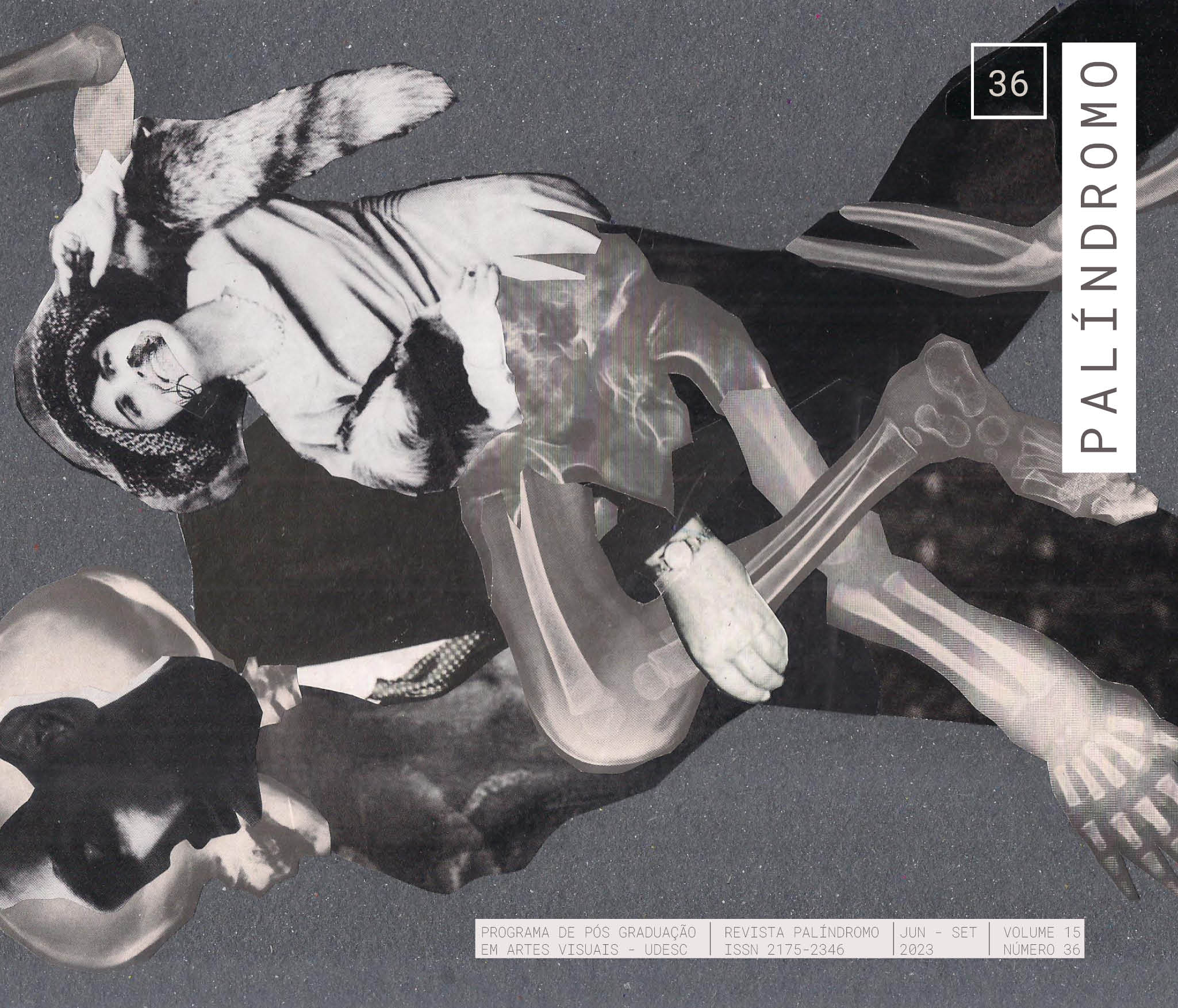O grotesco na Prancha 32 do Atlas Mnemosyne
DOI:
https://doi.org/10.5965/2175234615362023e0006Parole chiave:
Atlas Mnemosyne, Aby Warburg, grotesco, prancha 32 do Atlas MnemosyneAbstract
A categoria do grotesco é abordada através da análise da prancha 32 do Atlas Mnemosyne de Aby Warburg. Nela encontram-se imagens relativas principalmente ao Renascimento, abordando temas que atravessam os tempos desde a Antiguidade, como a dança da moresca, a corte amorosa e o culto à deusa Vênus, o gênero pictórico das Singeries (macaquices) e a luta pelos calções. Constata-se o vigor da categoria estética do grotesco, quando Aby Warburg dedica uma prancha apenas para ela. Juntamente com a análise das imagens, percorre-se as definições e reflexões sobre o grotesco em André Chastel, Wolfgang Kayser, e, principalmente em Victor Hugo, com seu postulado fundamental de que a forma grotesca se opõe ao clássico e existe na natureza e no mundo em nossa volta, mesmo que em um caleidoscópio de (in) definições. Outras categorias estéticas são abordadas em paralelo, como o belo, para o qual o grotesco surge como contraste; o cômico; o feio, com sua diversidade contrastante à unidade do belo. As imagens selecionadas por Warburg perpassam tais discussões teóricas e revelam polaridades fundamentais para compreender a expressão das comoções humanas: dionisíaco- apolíneo, loucura-razão, animal-humano, libertação-domesticação, caos-ordem, pathos-logos, distanciamento-imersão, expansão energética – contenção energética. Buscou-se igualmente compreender um método em Aby Warburg, seja na seleção e organização das imagens na prancha; seus interesses temáticos, nesse caso, as festas e tradições populares; o seu interesse pelo dissonante, para além das generalizações reducionistas e dos objetos canônicos da história da arte.
Downloads
Riferimenti bibliografici
BAXANDALL, Michael. The Limewood Sculptors of Renaissance Germany. New Haven/London: Yale University Press, 1981.
BOGERS, J. The Battle between Carnival and Lent (2010). Disponível em: https://www.rijksmuseum.nl/en/collection/SK-A-1673/catalogue-entry?pdfView=False Disponível em: 29 mar. 2023.
CASSIRER, E. Epitáfio a Aby Warburg (1929).Tradução de I.C. Fragelli. In: Discurso,46(1), p. 271-282, 2016. Disponível em: https://doi.org/10.11606/issn.2318-8863.discurso.2016.119172 Acesso em:10 fev.2023 DOI: https://doi.org/10.11606/issn.2318-8863.discurso.2016.119172
CASTIGLIONE, Baldesar. O livro do cortesão. Porto: Campo das Letras, 2008.
CENTANNI, Monica; MAZZUCCO, Katia. Introduction to Mnemosyne Atlas Panels. Engramma, n. 1, set. 2000. Disponível em: http://www.engramma.it/eOS/index.php?id_articolo=4891 Acesso em 29 mar. 2023.
CHASTEL, André. La grottesca. Milano: Abscondita, 2010. (Originalmente 1991)
ECO, Umberto. História da feiura. Rio de Janeiro: Record, 2015.
GINZBURG, Carlo. Mitos, emblemas, sinais: morfologia e história. São Paulo: Companhia das Letras, 1990.
HALL, James. Dictionary of Symbols and Subjects in Art. New York: Harper & Row, 1979.
HUGO, Victor. Do grotesco e do sublime (Prefácio de Cromwell). Trad. Celia Berretini. São Paulo: Perspectiva, 2014.
KAYSER, Wolfgang. O grotesco. São Paulo: Perspectiva, 2013.MEDEIROS, Afonso; PEREIRA, Marcos Villela. Chamada de artigos para o Dossiê número 36 da Revista Palíndromo: As artimanhas do grotesco no contemporâneo. 2022. Disponível em < https://www.revistas.udesc.br/index.php/palindromo/announcement/view/457> Acesso em 10 jan.2023.
MNEMOSYNE, Seminario. Il Laocoonte: desiderio di una formula patetica antica e fortuna del soggetto Letture grafiche di Mnemosyne Atlas, Tavola 41a. Engramma, 25, mag.-giug. 2003. Disponível em: http://www.engramma.it/eOS/index.php?id_articolo=3694 Acesso em 24 mar. 2023.
MNEMOSYNE ATLAS 32. Disponível em: http://www.engramma.it/eOS/core/frontend/eos_atlas_index.php?id_tavola=1032 Acesso em 24 fev. 2023.
NUTTALL, Paula. Low life, high Society: a group of comic-grotesque drawings by Verrocchio. Renaissance Studies, v. 35, n. 2. pp. 287-317, apr. 2021. DOI: https://doi.org/10.1111/rest.12663
SODRÉ, Muniz; PAIVA, Raquel. O império do grotesco. Rio de Janeiro: Mauad, 2014.
VASARI, Giorgio. Vidas dos artistas. São Paulo: Martins Fontes, 2011.
VÁZQUEZ, Adolfo. S. Um convite à estética. Trad.: Gilson Baptista Soares. Rio de Janeiro: Civilização Brasileira, 1999.
THE MORRIS DANCERS. Münchner Stadtmuseum. Disponível em: https://www.muenchner-stadtmuseum.de/en/collections/applied-arts-collection/the-morris-dancers#:~:text=Made%20by%20the%20sculptor%20Erasmus,at%20the%20major%20European%20courts. Acesso em 25 mar. 2023.
TIBERINI, Elvira Stefania. La moresca: aspetti sociocultural di uma danza Popolare tradizionale in ter diversi contesti etnografici. L’Uomo, v. 2, n. 2. pp.193-213, 1982.
WARBURG, Aby. Atlas Mnemosyne. Paris: l’Écarquillé, 2012.
WARBURG, Aby. A arte italiana e a astrologia internacional no Palazzo Schifanoia, em Ferrara. In: A Renovação da Antiguidade pagã: Contribuições científico-culturais para a história do Renascimento europeu. Rio de Janeiro: Contraponto, 2013a. p. 453-506.
WARBURG, Aby. O nascimento de Vênus e A primavera de Sandro Botticelli (1893). In: A Renovação da Antiguidade pagã: Contribuições científico-culturais para a história do Renascimento europeu. Rio de Janeiro: Contraponto, 2013b. p. 3-88.
WARBURG, Aby. Os figurinos teatrais para os intermezzi de 1589 (1895). In: A Renovação da Antiguidade pagã: Contribuições científico-culturais para a história do Renascimento europeu. Rio de Janeiro: Contraponto, 2013c. p. 339-426.
WARBURG, A. Dürer e a Antiguidade italiana (1905). In: A Renovação da
Antiguidade Pagã: Contribuições científico-culturais para a história do Renascimento europeu.. Rio de Janeiro: Contraponto, 2013d. p. 435-445.
WARBURG, Aby. Introdução à Mnemosine. In: Histórias de fantasma para gente grande. São Paulo: Companhia das Letras, 2015. p. 363-375.
WARBURG, Aby. Bilderatlas Mnemosyne: The Original. Berlin: Hatje Cantz, 2020.
WEDEKIN, Luana. No caminhar da ninfa: processos de potencialização e domesticação da imagem em Warburg e Panofsky. In: 27o Encontro da Associação Nacional de Pesquisadores em Artes Plásticas, 2018, São Paulo. Práticas e ConfrontAÇÕES Anais [recurso eletrônico] do 27o Encontro da Associação Nacional de Pesquisadores em Artes Plásticas, setembro de 2018, São Paulo, SP. São Paulo: ANPAP/UNESP, 2018. v. 1. p. 1931-1946.
Downloads
Pubblicato
Come citare
Fascicolo
Sezione
Licenza
Copyright (c) 2023 Sandra Makowiecky, Luana Maribele Wedekin

TQuesto lavoro è fornito con la licenza Creative Commons Attribuzione 4.0 Internazionale.
DECLARAÇÃO DE DIREITOS AUTORAIS
a. Os artigos publicados pela revista são de uso gratuito, destinados a aplicações acadêmicas e não comerciais. Todos os direitos autorais são atribuídos à revista. Os artigos cujos autores são identificados representam a expressão do ponto de vista de seus autores e não a posição oficial da Revista Palíndromo. O (s) autor (es) compromete-se sempre que publicar material referente ao artigo publicado no Palíndromo mencionar esta publicação da seguinte forma:
Este artigo foi publicado originalmente pela revista Palíndromo em seu volume (coloque o volume), número (coloque o número) no ano de (coloque o ano) e pode ser acessado em: http://www.revistas.udesc.br/index.php/palindromo
b. Plágio, em todas as suas formas, constitui um comportamento antiético de publicação e é inaceitável. A revista Palíndromo utiliza o software iThenticate de controle de similaridade


